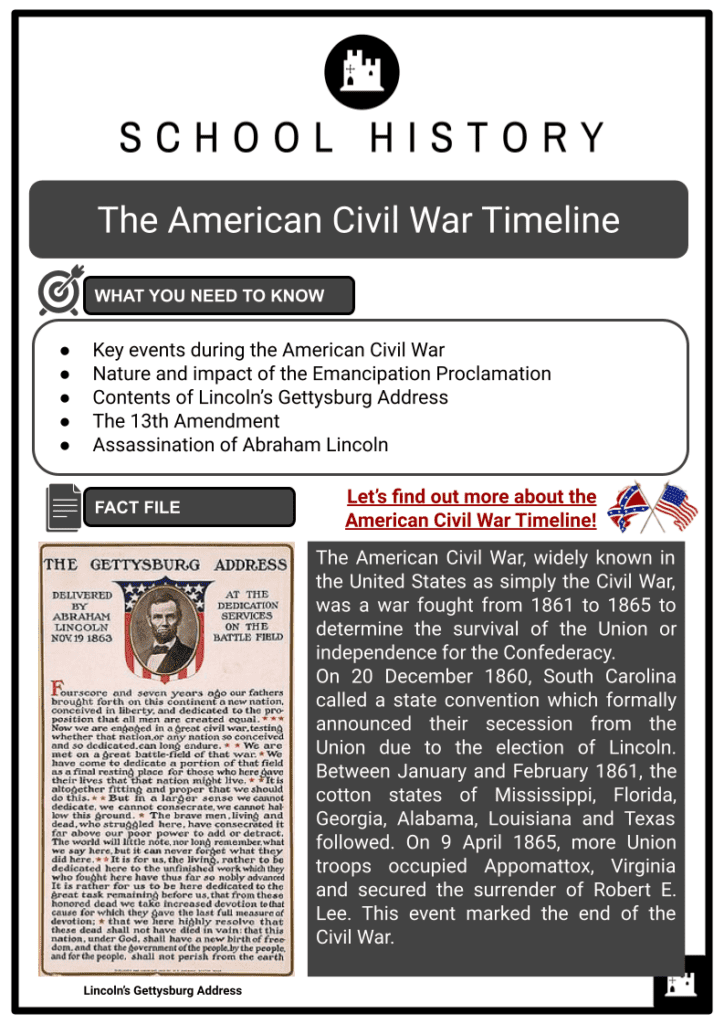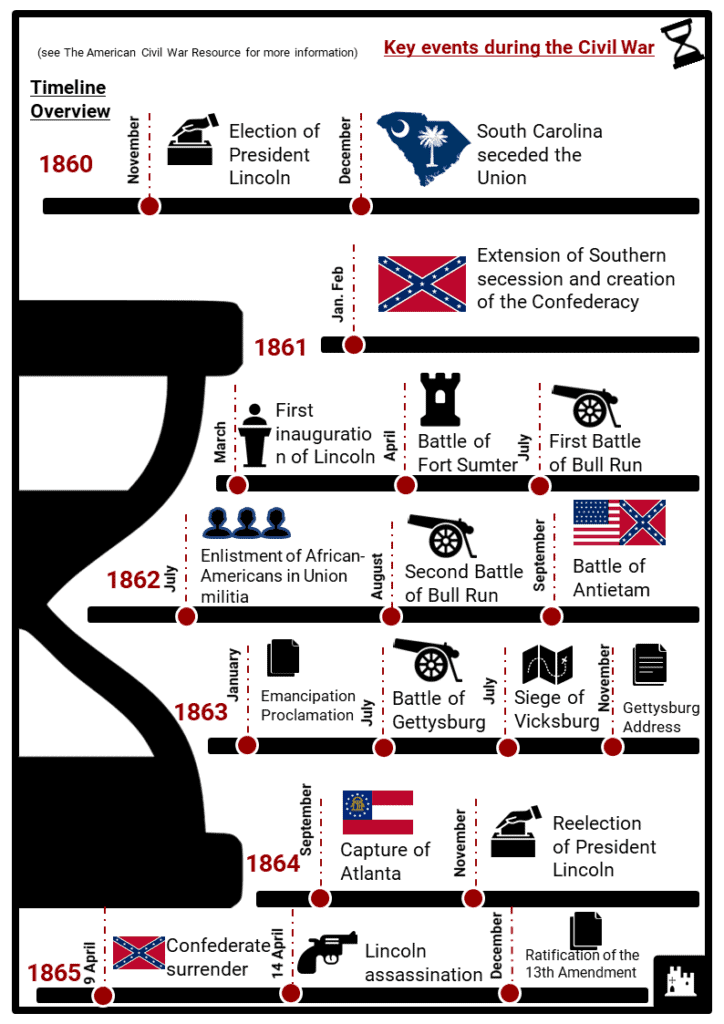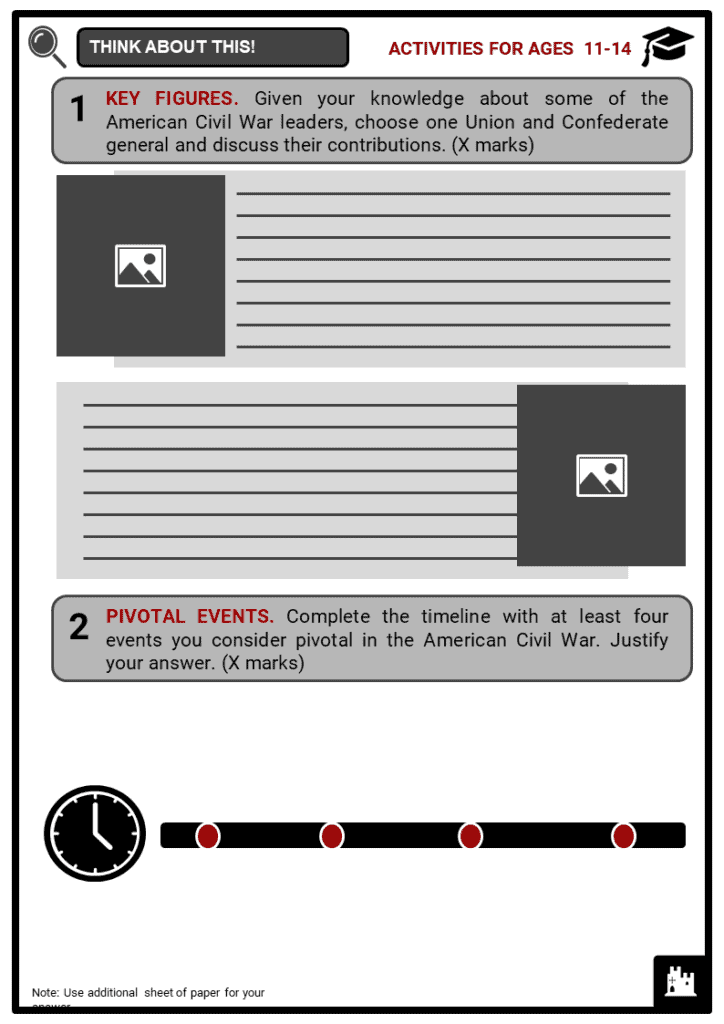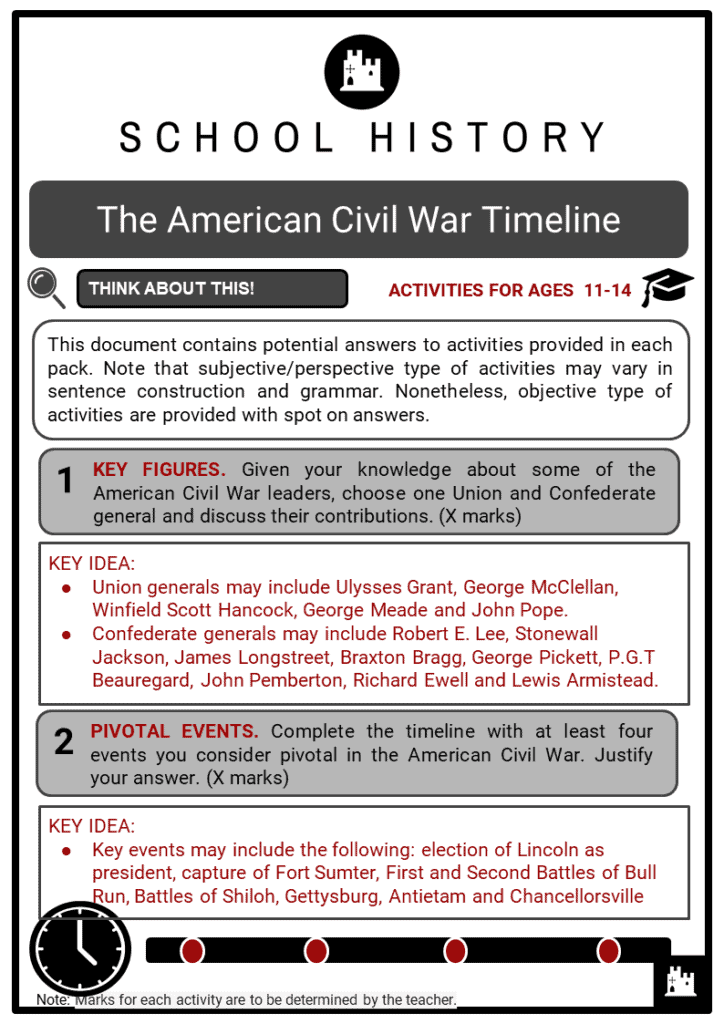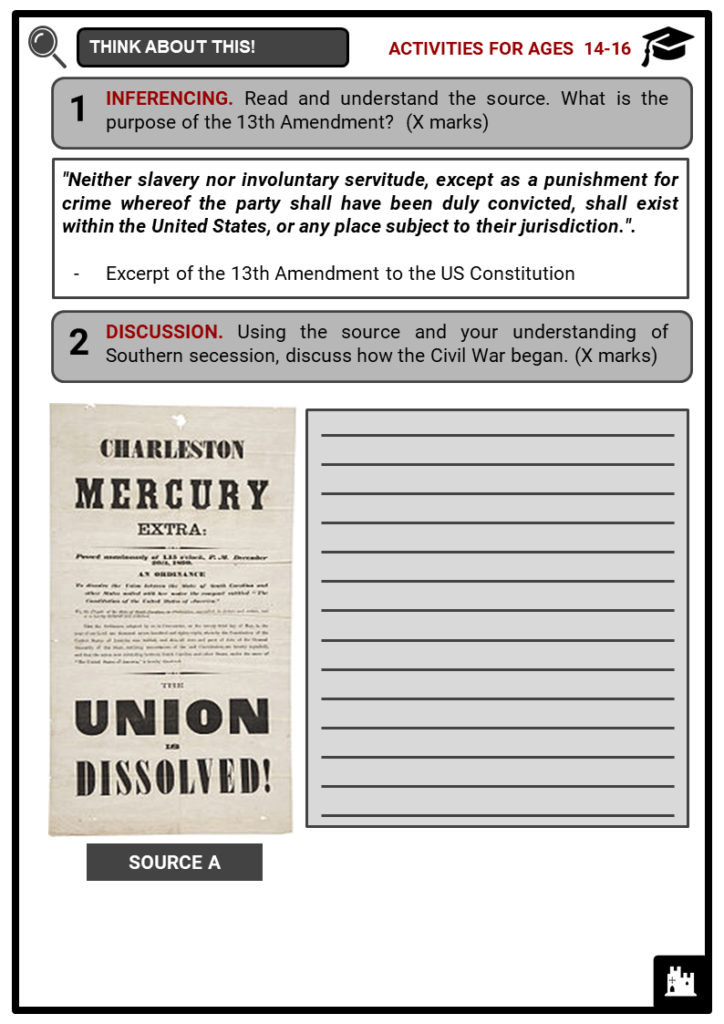Download American Civil War Timeline Worksheets
Do you want to save dozens of hours in time? Get your evenings and weekends back? Be able to teach American Civil War Timeline to your students?
Our worksheet bundle includes a fact file and printable worksheets and student activities. Perfect for both the classroom and homeschooling!
Summary
- Key events during the American Civil War
- Nature and impact of the Emancipation Proclamation
- Contents of Lincoln’s Gettysburg Address
- The 13th Amendment
- Assassination of Abraham Lincoln
Key Facts And Information
Let’s find out more about the American Civil War Timeline!
- The American Civil War, widely known in the United States as simply the Civil War, was a war fought from 1861 to 1865 to determine the survival of the Union or independence for the Confederacy.
- On 20 December 1860, South Carolina called a state convention which formally announced their secession from the Union due to the election of Lincoln. Between January and February 1861, the cotton states of Mississippi, Florida, Georgia, Alabama, Louisiana and Texas followed. On 9 April 1865, more Union troops occupied Appomattox, Virginia and secured the surrender of Robert E. Lee. This event marked the end of the Civil War.
Key events during the Civil War
Election of Abraham Lincoln, 1860
- With divided Democrats, Abraham Lincoln was elected as the 16th President of the United States in November 1860. He won the election with 180 electoral votes and nearly 40% of the popular vote against candidates Douglas, Breckinridge and Bell.
- The 1860 election identified the Democratic and Republican Parties. It also intensified the division between slave and free states between the South and the North.
- Carrying anti-slavery platform of the new Republican Party, Lincoln’s election angered pro-slavery politicians.
- All of Lincoln’s votes came from the North as not a single Southerner liked him. Amidst being a Democrat, Stephen Douglas refused to adopt pro-slavery platform. Douglas was popular during his debates against Lincoln in Illinois, where they were both from.
South Carolina seceded from the Union, 1860
- Immediately after Lincoln’s election, South Carolina seceded from the Union on 20 December. Months before the election, state governor William Gist campaigned with other governors that South Carolina would secede if Lincoln got elected.
- Days after Lincoln’s election, the South Carolina General Assembly convened. It was attended by 169 delegates who voted unanimously calling for secession.
- The brief Ordinance of Secession issued on 20 December was reinforced with the South Carolina Declaration of Secession released four days later.
- The declaration specifically identified the increasing hostility on the part of the non-slaveholding states to the institution of slavery as the main reason for secession.
- South Carolina asserted that the federal government had limited powers over sovereign states.
Extension of Southern secession and creation of the Confederacy, 1861
- Between January and February 1861, the cotton states of Mississippi, Florida, Georgia, Alabama, Louisiana and Texas followed South Carolina. After the states from the deep south, Virginia, Tennessee, Arkansas and North Carolina followed. Early in February 1861, representatives met in Montgomery, Alabama, to draft their own constitution.
- They also elected Jefferson Davis, Senator of Mississippi, as president, and Alexander Stephens of Georgia, as vice president.
- On 11 March 1861, the Confederates permanently adopted a constitution that was almost the same as the federal one, but with more distinct states’ rights. On 23 May 1861, the Confederate capital was proposed to transfer from Montgomery, Alabama, to Richmond, Virginia.
First inauguration of Lincoln, 1861
- Lincoln took his oath and delivered his first inaugural address from the east front of the Capitol. He appealed for friendship between all states of the US and made it clear that he did not intend to abolish slavery in states where it existed at that time.
- He asserted that the US Constitution should be executed to all states, including those that seceded.
- Lincoln promised that he would not use force against the South unless necessary.
- With regard to federal offices in the South, he promised that the spoils system would not be used.
- The Charleston Mercury stated that Lincoln’s speech manifested insolence and brutality. It obviously did not impress the Southern states.
- “We are not enemies, but friends. We must not be enemies. Though passion may be strained, it must not break our bonds of affection. The mystic chords of memory, stretching from every battlefield and patriot grave to every living heart and hearthstone all over this broad land, will yet swell the chorus of the Union, when again touched, as surely they will be, by the better angels of our nature.” - Lincoln’s closing remarks
Battle of Fort Sumter, 1861
- On 12 April the first shots of the war were fired at Fort Sumter, South Carolina. Since South Carolina seceded, it demands that Union troops leave the forts they hold in the state. When the Union refuses and instead tries to resupply their troops by boat, the vessel is fired on by the state militia.
- After holding out for around a day and a half, the Union commander agrees to surrender the fort. A few days later, Lincoln summons a militia numbering 75,000 men in the North, saying that the rift between the Northern and Southern states is too serious to be settled judicially.
- Four more ‘border’ states, Virginia, Tennessee, Arkansas and North Carolina, join the Confederacy.
- Robert E. Lee is offered command of the Union army but refuses to fight against his native state, Virginia. He instead became one of the leading commanders of the Confederacy. Lincoln orders Southern ports to be blockaded in an attempt to hamper the war efforts of the Confederacy.
First Battle of Bull Run, 1861
- The First Battle of Bull Run takes place near Manassas, Virginia, after the Union Army mounts an attack to try and push Confederate forces away from the capital, Washington D.C. Although neither side is convincing on the battlefield, the Confederates are victorious after receiving reinforcements by train and sending Union troops into a chaotic retreat.
- There are almost five thousand casualties – killed, wounded, missing or captured. Confederate General Thomas Jackson earned his nickname ‘Stonewall’ at this battle.
- The failure of the Confederates is blamed on Jefferson Davis and generals Beauregard and Johnston.
- On the side of the Union, Lincoln replaces McDowell with George McClellan who reorganises the troop, which later become known as the Army of the Potomac.
Events following the First Battle of Bull Run
- In November 1861, Unionists took two Confederate diplomats off a British vessel in an incident known as the Trent Affair, nearly sparking war with Britain.
- By February 1862, the Battles of Fort Henry and Fort Donelson, Tennessee, spelled victories for the Union side. Following the capture of these forts, on the Tennessee and Cumberland Rivers respectively, the Union armies can use the rivers to navigate deep into Confederate territory. The victory enhances the reputation of Union General Ulysses S. Grant.
- In March 1862, the Battle of Ironclads, also known as the Battle of Hampton Roads in Virginia, is a naval clash brought about by the Confederacy’s attempts to break the Union blockade of its ports.
- The use of armoured ships in battle is historic, but the result is inconclusive – despite the Confederacy inflicting greater damage on the Union fleet, it fails to stop the blockade.
- In April 1862, the Battle of Shiloh in Tennessee is a failed attempt by the Confederacy to drive the Union army back and stop it from entering the state of Mississippi. It became the bloodiest battle in American history at the time, with 23,700 casualties, although later it was surpassed by other Civil War battles in this regard. That same month, Union troops also captured the key Confederate city of New Orleans.
- In June 1862, during the Peninsula Campaign, Union troops try to capture the Confederate capital, Richmond, Virginia. When Robert E. Lee replaces Joseph E. Johnston as Confederate commander, he revitalises his troops and goes on the offensive during the Seven Days’ Battle. The Union army retreats without taking Richmond.
Enlistment of African-Americans in Union militia, 1862
- On 17 July 1862, Congress approved the enlisting of Black soldiers into the Union army, a change of policy. The Second Confiscation and Militia Act authorises the enlistment of any persons of African descent in the militia to suppress the rebellion.
- Infantry units composed of African-Americans are formed in New Orleans, Louisiana, Kansas and South Carolina. In February 1863, Massachusetts governor John A. Andrew issued the first official call for African-American soldiers.
- About one-quarter of soldiers recruited to the 54th Massachusetts Infantry Regiment come from slave states, others are from Canada and the Caribbean. It is the first African regiment formed in the North.
- In July 1863, the 54th Massachusetts guards Port Charleston in South Carolina.
- In the initial months following the recruitment of African-Americans, they are paid $10 a week, compared to $13 for white soldiers. In 1864, Congress passed a bill that authorises equal pay for both.
- When the war ended in 1865, about 180,000 African-American soldiers served in the army. Half are formerly enslaved people from the South, while the rest are freed African-Americans from both border and Northern states.
Second Battle of Bull Run, 1862
- In August 1862, the Second Battle of Bull Run takes place in Manassas, Virginia, after Confederate troops capture a Union supply depot. The Union Army was defeated again by Confederates under Stonewall Jackson and Lee.
- Replacing General McClellan, President Lincoln appoints Major General John Pope to command the Army of Virginia. Organised in two wings by about 55,000 men led by Major General James Longstreet and Major General Stonewall Jackson, the Confederate army crashes Pope’s division.
- For the Confederates, the result of this battle begins their northward movement. General Lee’s troops reach Maryland by September. In total, there were about 22,180 casualties, with 13,830 from the Union.
Battle of Antietam, 1862
- In September, after the Confederate Army invaded Union territory, the two sides met at the Battle of Antietam in Maryland. The battle is inconclusive yet historic, the bloodiest single day in US military history, with almost 23,000 casualties.
- Also known as the Battle of Sharpsburg, the military encounter at Antietam Creek is Lee’s culmination to invade the North. Lee’s Army of Northern Virginia faces McClellan’s Army of the Potomac.
- Following Union defeat in the Second Battle of Bull Run, President Lincoln’s Cabinet hesitates to release the Emancipation Proclamation.
- To maintain Southern morale, General Lee issued Special Order 191, also known as the Maryland Campaign. It is a plan to invade Northern states, particularly Maryland and West Virginia. However, a copy of the plan was allegedly discovered by two Union soldiers.
- McClellan hurriedly reports the discovery and immediately moves his army to foil Lee’s invasion plan.
- On 17 September, the Battle of Antietam begins. After eight hours of battle in a cornfield owned by David Miller, there were over 15,000 casualties. Union troops are able to push back Confederates at Sunken Road.
- After 12 hours of battle, the encounter resulted in 23,000 casualties with about 4,000 dead. The following day, Lee’s troops retreat to Virginia, while McClellan does nothing. Despite Union victory, President Lincoln is disappointed with McClellan’s action. He thinks that the general missed a great opportunity to attack the Army of Northern Virginia. As a result, Lincoln removed McClellan from command.
Emancipation Proclamation, 1863
- On New Year’s Day, Lincoln issued the Emancipation Proclamation, which liberates some three and half million enslaved people in the Southern states. Lincoln explains that the proclamation was a wartime measure for states under rebellion. The proclamation did not cover Border states and Southern states controlled by the Union Army.
- Despite having little effect on the institution of slavery, the Emancipation Proclamation gets the attention of Britain and France, who consider supporting the Southern cause. Foreign observers backed off due to opposition to slavery.
- About 200,000 African-Americans joined the Union Army which greatly contributed to their victory.
- When the war ends, Lincoln’s Emancipation Proclamation becomes the basis of the 13th Amendment which constitutionally abolished slavery in the United States.
Events following the Emancipation Proclamation
- In March 1863, Congress passed the Enrollment Act, which orders the conscription of men into the Union Army. The wealthy class shows resentment and pays instead of serving. Moreover, Lincoln offers amnesty to tens of thousands of deserters who would return to join the army.
- Between April and May 1863, General Lee led a Confederate victory at the Battle of Chancellorsville in Virginia, but this comes at a heavy cost - the death of Stonewall Jackson.
Battle of Gettysburg, 1863
- In July, the Battle of Gettysburg became a major turning point in the war. The Union army defeated the Confederates in their attempt to invade Pennsylvania.
- After the Confederate victory at the Battle of Chancellorsville, Lee is eager to invade the North and show European countries which side to support.
- With more than 71,000 Confederate troops, Lee marches into Pennsylvania. Early in July, advancing Confederates clashed with the Union Army of the Potomac, led by General George Meade.
- Two days later, Lee orders an assault at Cemetery Ridge, known as Pickett’s Charge. The assault fails and Lee retreats to Virginia. There were heavy casualties on both sides, and the Confederates never again reached Union territory.
Siege of Vicksburg, 1863
- Between May and July 1863, Union troops led by General Grant launched a campaign to take Confederate control over Vicksburg, Mississippi. In addition to being one of the most successful Union campaigns, the siege is also the longest. After the defeat of Confederate General John Pemberton, he retreated to Vicksburg. Grant then takes the city under siege.
- In the span of three weeks, Grant’s soldiers win five battles and held about 6,000 prisoners.
- In order to enclose Pemberton and his troops, Grant orders the construction of a 15-mile trench. From both the east and west, the Confederate army attempts to rescue their comrades inside Vicksburg, but they do not succeed.
- On 4 July 186, Pemberton surrendered. The siege solidifies Grant’s military career.
Gettysburg Address, 1863
- On 19 November, Lincoln delivers a two-minute speech at a ceremony to commemorate the war dead, referring to the Declaration of Independence and the importance of unity. This brief oration becomes known as the Gettysburg Address. Meanwhile, the Union Army scores an important victory at the Battle of Chattanooga.
- "Fourscore and seven years ago our fathers brought forth, on this continent, a new nation, conceived in liberty, and dedicated to the proposition that all men are created equal. Now we are engaged in a great civil war, testing whether that nation, or any nation so conceived, and so dedicated, can long endure. We are met on a great battlefield of that war. We have come to dedicate a portion of that field, as a final resting-place for those who here gave their lives, that that nation might live. It is altogether fitting and proper that we should do this. But, in a larger sense, we cannot dedicate, we cannot consecrate—we cannot hallow—this ground. The brave men, living and dead, who struggled here, have consecrated it far above our poor power to add or detract. The world will little note, nor long remember what we say here, but it can never forget what they did here. It is for us the living, rather, to be dedicated here to the unfinished work which they who fought here have thus far so nobly advanced. It is rather for us to be here dedicated to the great task remaining before us—that from these honored dead we take increased devotion to that cause for which they here gave the last full measure of devotion—that we here highly resolve that these dead shall not have died in vain—that this nation, under God, shall have a new birth of freedom, and that government of the people, by the people, for the people, shall not perish from the earth." - President Lincoln’s Gettysburg Address
Events following Lincoln’s Gettysburg Address
- In March 1864, Ulysses S. Grant was named commander-in-chief of the Union Armies.
- The following month, news of a massacre of hundreds of surrendering African-American Union troops at Fort Pillow, Tennessee, horrifies the Northern states.
- The battles of Wilderness and Spotsylvania in Virginia mark the start of a Union campaign to advance to Richmond, although they are inconclusive.
- In June 1864, the battle of Cold Harbor in Virginia caused the Union Army heavy casualties, but Confederates are now on the defensive. There was also a Union victory in a naval clash near Cherbourg, France, but a Confederate victory at the Battle of Kennesaw Mountain in Georgia, as Union troops under General Sherman marched on Atlanta.
- By July, Confederate troops attacked Washington D.C. to draw off Union troops from elsewhere, although they could not take the city. Meanwhile, Union troops won a victory at the Battle of Atlanta, although the city has not yet fallen.
- In August, victory at the Battle of Mobile Bay enabled Union forces to enforce a total blockade of Southern ports. The key city of Atlanta was finally captured by the Union Army in September.
- In October, the Union victory at the Battle of Cedar Creek in Virginia put a permanent end to the Confederate's ability to threaten Washington D.C.
Reelection of President Lincoln, 1864
- On 8 November 1864, Northerners again showed their support for Lincoln when they elected him to a second term. Lincoln defeated his former army general, Democrat George B. McClellan. With 212 electoral votes to 21, Lincoln wins the election. Despite being in a military emergency, Lincoln believes that an election should be taken in order to assure its people a free form of government.
- “We can not have free government without elections; and if the rebellion could force us to forego or postpone a national election, it might fairly claim to have already conquered and ruined us.” - Abraham Lincoln on the 1864 election
Confederate surrender, 1865
- On 9 April 1866, General Lee surrenders his 28,000 troops to General Grant in Appomattox Court House, Virginia. This surrender marks the end of the Civil War.
- Upon surrender, Lee lists his terms to Grant. This includes the pardon and safe return of all officers. He also demands Union rations to his starving men.
- Grant responds that “the war is over. The rebels are our countrymen again”.
Lincoln assassination, 1865
- Despite the surrender of General Lee, the Confederate cause did not instantly fade away. On the evening of 14 April 1865, Lincoln was assassinated by John Wilkes Booth, a Confederate sympathiser, while at Ford’s theatre with his wife, Mary.
- Lincoln died the next morning from a shot he suffered to the head. Booth belongs to a family of well-known stage actors who strongly support slavery.
- After Lincoln’s assassination, Vice President Andrew Jackson assumed authority. Johnson agrees with the rebuilding of the South.
- Despite his Southern roots, Johnson agreed with Congress when harsher laws were passed for Southern states. The Reconstruction Era sees new amendments to the Constitution.
- Three days after Lincoln’s death, his body was taken to the Capitol before his remains were taken to Illinois.
- Tens of thousands of Americans wait along the railway to pay their respects to the former president.
- On 4 May, Lincoln’s remains are interred at Oak ridge Cemetery with his son Willie.
Ratification of the 13th Amendment, 1865
- On 31 January 1865, the 13th Amendment to the Constitution was passed by Congress. It was ratified on 6 December of the same year. The 13th Amendment legally abolished slavery or any form of involuntary servitude in the United States.
- The passage of the 13th Amendment through a joint resolution of Congress is Lincoln’s last legacy as president of the United States. His death caused ratification to be postponed.
- After a year, the first civil rights bill in the US was passed by Congress. The Civil Rights Act of 1866 outlaws the Black Codes or laws used by the former Confederate States towards African-Americans. Moreover, Congress requires all former Confederate states to first ratify the 13th Amendment before regaining representation in the federal government.
- Also during the Reconstruction Era, the 14th and 15th Amendments were passed and ratified in attempts to provide equal treatment and opportunities to African-Americans.

